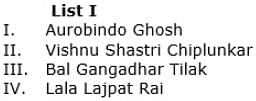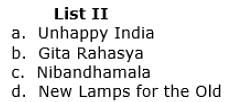MH SET Paper 2 Mock Test - 1 (History) - MAHA TET MCQ
30 Questions MCQ Test MH SET Mock Test Series 2025 - MH SET Paper 2 Mock Test - 1 (History)
Which of the following text was found in the Aryan expansion of 6th and 7th centuries BC?
As per the Dual government the Company got the Diwani rights. For exercising the functions company appointed two deputies Diwans, one for Bengal and one for Bihar. Who was appointed as deputy diwan for Bihar?
Assertion: Lord Rippon followed spirited forward policy towards Afghanistan
Reason: Lord Rippon dumped erstwhile policy of "Masterly Inactivity"
Logographers, the predecessors of Greek historians, are MOST distinguished from Herodotus, the "Father of History," by their:
With reference to Dhrupad, one of the major traditions of India that has been kept alive for centuries, which of the following statements are correct?
1) Dhrupad originated and developed in the Rajput kingdoms during the Mughal period.
2) Dhrupad is primarily a devotional and spiritual music.
3) Dhrupad Alap uses Sanskrit syllables from Mantras.
Select the correct answer using the codes given below :
Which of the following acts abolished the dyarchy in provinces?
consider the following statement about Junagarh Inscription :
1. The earliest specimen of the Kavya style was found in the Junagarh Inscription.
2. This inscription was made under the rule of Rudradaman 1.
3. This inscription was written in the Prakrit language.
Which of the statements given above is/are correct?
The correct chronology of the conquests of Alauddin Khilji is:
(i) Conquest of Chittorgarh
(ii) Conquest of Gujarat
(iii) Conquest of Ranthambore
(iv) Second Campaign of Devgiri
The statement "The so-called first national war of independence was neither first, nor national, nor a war of independence" is associated with-
In the context of Indian history, the Rakhmabai case of 1884 revolved around:
1. Women’s right to gain education
2. Age of consent
3. Restitution of conjugal rights
Select the correct answer using the code given below:
Below given are two statements, one is labelled as Assertion (A) and the other as Reason (R):
Assertion (A) : The Congress Boycotted the Simon Commission.
Reason (R) : The Commission did not have a single Indian member.
Codes:
With reference to the system of ‘Subsidiary Aliances’, consider the following statements.
1) Under this system, the ruler of the allying Indian state was to be provided with the British defence forces only when required.
2) The ruler also sometimes ceded part of his territory instead of paying annual subsidy.
3) The ruler could employ any European in his service at his court.
Choose the incorrect answer
As a Gandhian, if you were to practise the idea of 'Satyagraha', you would emphasise upon :
A. Winning battles by being aggressive.
B. Appealing to the conscience of the oppressor.
C. Resist passively and engage with intense activity.
D. The power of truth and the need to search for the truth by seeking vengeance.
With reference to the history of philosophical thought in India, consider the following statements regarding Sankhya school :
1. Sankhya does not accept the theory of rebirth or transmigration of soul.
2. Sankhya holds that it is the self – knowledge the leads to liberation and not any exterior influence or agent.
Which of the statements given above is / are correct?
Match List I with List II, and select the correct answer by using the codes given below the lists:
List I
I. Jawaharlal Nehru
II. Sardar Patel
III. J.B. Kripalani
IV. Dr. Rajendra Prasad
List II
a. States Committee
b. Provincial Constitution Committee
c. Steering Committee
d. Fundamental Rights Sub-Committee
Codes:
From the time England acquired political power in India, she destroyed Indian Industries principally by means of:
1) Forcing of British Free Trade on India.
2) Compelling Old East India Company merchants to divulge their trade secrets.
3) The export of raw products from India.
4) Building railways in India.
Which of the above statements are correct.
Consider the following statements with respect to Gupta king Samudragupta:
1. He annexed all the kingdoms he conquered.
2. He conquests in the south reached as far as Kanchi near Chennai.
3. His achievements and conquests are recorded in the Allahabad pillar inscription.
Which of the statements given above are correct?
"The British empire is rotten to the core, corrupt in every direction and tyrannical and mean". This statement was made by-
Who of the following is considered as the father of the idea of Pakistan?
French East India Company was constructed during the reign of-
Indian Jute Mills Association was established in which year?
A Buddha can be born only as a Brahmin or a Kshatriya and not “in a low family such as that of a Chandala or of a basket-maker or of a chariot-maker or of a Pukkasa.” The given statement is taken from:
|
60 tests
|
















